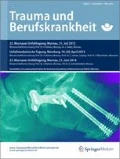Zusammenfassung
MRE (multiresistente Erreger) können nur sehr eingeschränkt oder nicht mehr antibiotisch behandelt werden. MRSA- bzw. OSRA-Stämme (methicillin- synonym oxacillinresistenter Staphylococcus aureus) sind gegenüber allen Betalaktamantibiotika, daneben häufig gegen Erythromycin, Clindamycin und Gentamycin resistent. Zudem werden gegen neue Medikamente sehr schnell Resistenzen entwickelt. Gleichzeitig kommt Staphylococcus aureus, einer der wichtigsten Erreger ambulanter pyogener, insbesondere aber nosokomialer Infektionen ubiquitär vor und hat zudem eine hohe Umweltresistenz. In den letzten Jahren hat die MRSA-Prävalenz weltweit zugenommen, die multiresistenten Erreger etablieren sich inzwischen auch außerhalb von Kliniken (cMRSA). Aufgrund der raschen Resistenzentwicklung können MRSA-Infektionen nicht langfristig durch die Neuentwicklung von potenten Antibiotika bekämpft werden. Infektionen durch MRSA-Stämme führen zu längeren Verweildauern im Krankenhaus und verursachen höhere direkte Kosten für Diagnostik und Therapie. Dies kann bei knapper werdenden finanziellen und personellen Ressourcen im Gesundheitssystem schnell zu kritischen Situationen führen. Der strikten Einhaltung krankenhaushygienischer Maßnahmen, der effektiven Infektionskontrolle, der Implementierung von Präventionsstrategien und der adäquaten antimikrobiellen Therapie kommt in der Senkung der MRSA-Prävalenz eine zentrale Stellung zu.
Abstract
Multiresistent pathogens can no longer be effectively controlled using antibiotics. Methicillin (MRSA) and oxacillin resistant (ORSA) Staphylococcus aureus are resistant to all beta-lactose antibiotics and are frequently resistant against erythromycin, clindamicin and gentamicin. In addition, resistance develops rapidly against new preparations. At the same time, Staphylococcus aureus, one of the most important pathogens of outpatient, pyogenic and in particular nosocomial infections, is cosmopolitan with a high environmental resistance. In recent years, there has been a worldwide increase in the prevalence of MRSA, including the spread of multiresitant pathogens outside of the clinical setting (cMRSA). Due to the rapid development of resistance, it will not be possible to combat these pathogens with newly developed, potent antibiotics in the long-term. Infections with MRSA clones lead to ever longer hospital stays with subsequent higher direct costs for diagnostics and therapy. Given the continually increasing restrictions in finances and personnel in the health system, this can rapidly lead to a critical situation. The strict maintenance of hospital hygiene, effective control of infections, implementation of preventive strategies and adequate antibiotic therapy play central roles in reducing the prevalence of MRSA.




Literatur
Back NA, Linnemann CC Jr, Staneck JL et al. (1996) Control of methicillin-resistant Staphylococcus aureus in a neonatal intensive-care unit: use of intensive microbiologic surveillance and mupirocin. Infect Control Hosp Epidemiol 17: 227–231
Boyce JM (1991) Should we vigorously try to contain and control methicillin-resistant Staphylococcus aureus? Infect Control Hosp Epidemiol 12: 46–54
Centers for Disease Control and Prevention (CDC) (2002) Staphylococcus aureus resistant to vancomycin — United States 2002. Morb Mortal Wkly Rep 51: 565–567
EARSS — European Antimicrobial Resistance Surveillance Study (2001) Annual Report 2001. EARSS, Bilthoven, NL
Fridkin SK, Hageman JC, Morrison M et al. (2005) Methicillin-resistant Staphylococcus aureus disease in three communities. N Engl J Med 352: 1436–1444
Geldner G, Ruoff M, Hoffmann HJ et al. (1999) [Cost analysis concerning MRSA-infection in ICU]. Anasthesiol Intensivmed Notfallmed Schmerzther 34: 409–413
Hayes PD, Nasim A, London NJ et al. (1999) In situ replacement of infected aortic grafts with rifampicin-bonded prostheses: the Leicester experience (1992 to 1998). J Vasc Surg 30: 92–98
Herr CE, Heckrodt TH, Hofmann FA et al. (2003) Additional costs for preventing the spread of methicillin-resistant Staphylococcus aureus and a strategy for reducing these costs on a surgical ward. Infect Control Hosp Epidemiol 24: 673–678
Kilgus DJ, Howe DJ, Strang A (2002) Results of periprosthetic hip and knee infections caused by resistant bacteria. Clin Orthop Relat Res 2002: 116–124
Kipp F, Friedrich AW, Becker K et al. (2004) Bedrohliche Zunahme Methicillin-resistenter Staphylococcus-aureus-Stämme. Dtsch Arztebl 101: 2045–2050
Kreutzer J, Nußbaum B, Bernd L et al. (2002) Reale Kosten der MRSA-Osteitis — eine retrospektive Studie im Zeitraum von 1996–2001. Trauma Berufskrankh 4: 344
Muckley T, Hierholzer C, Diefenbeck M et al. (2004) [Treatment of MRSA infection in orthopedic surgery]. Chirurg 75: 269–275
Murphy GJ, Pararajasingam R, Nasim A et al. (2001) Methicillin-resistant Staphylococcus aureus infection in vascular surgical patients. Ann R Coll Surg Engl 83: 158–163
NN (2005) Diskussion zu dem Beitrag von Kipp et al. „Bedrohliche Zunahme Methicillin-resistenter Staphylococcus-aureus-Stämme“. Dtsch Arztebl 102: 898–902
Peltroche-Llacsahuanga H, Haase G, Lutticken R et al. (1998) [Methicillin-resistant Staphylococcus aureus (MRSA) — clinical implications]. Chirurg 69: 801–805
Popp W, Hilgenhöner M, Leisebein T et al. (2003) Personalkosten durch Isolierungsmaßnahmen von MRSA-Patienten. Gesundheitsökonomie Qualitätsmanagement 8: 187–190
RKI (2003) Staphylokokken-Erkrankungen, insbesondere Infektionen durch MRSA. RKI-Ratgeber Infektionskrankh 2003: 1–13
RKI (2003) Methicillin-resistente Staphylococcus aureus (MRSA) in deutschen Alten- und Pflegeheimen — zur Situation. Epidemiol Bull RKI 19: 145–148
Tsiodras S, Gold HS, Sakoulas G et al. (2001) Linezolid resistance in a clinical isolate of Staphylococcus aureus. Lancet 358: 207–208
Interessenkonflikt:
Keine Angaben
Author information
Authors and Affiliations
Corresponding author
Rights and permissions
About this article
Cite this article
Mückley, T., Diefenbeck, M. & Hofmann, G.O. MRSA-Infektionen am muskulo-skelettalen System. Trauma Berufskrankh 9 (Suppl 1), S69–S74 (2007). https://doi.org/10.1007/s10039-005-1063-1
Issue Date:
DOI: https://doi.org/10.1007/s10039-005-1063-1
Schlüsselwörter
- MRE (multiresistenter Erreger)
- MRSA (methicillinresistenter Staphylococcus aureus)
- OSRA (oxacillinresistenter Staphylococcus aureus)
- Prävention
- MRSA-Management

